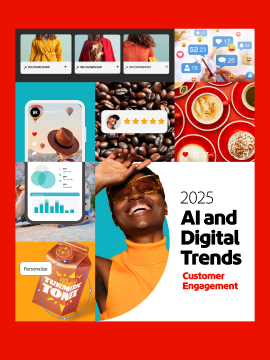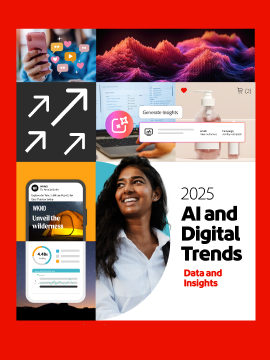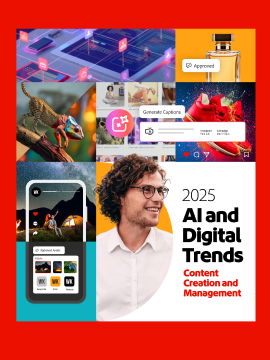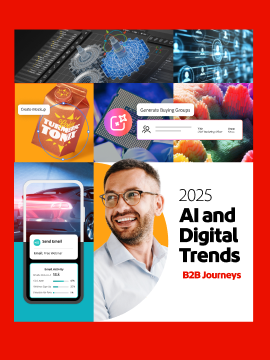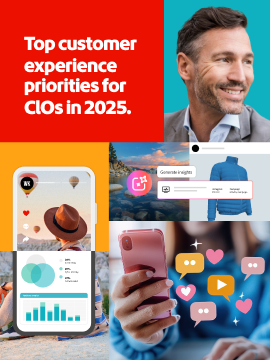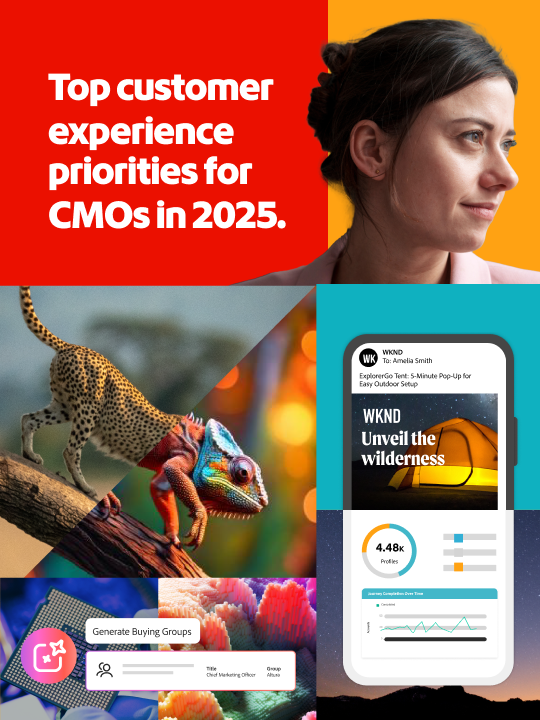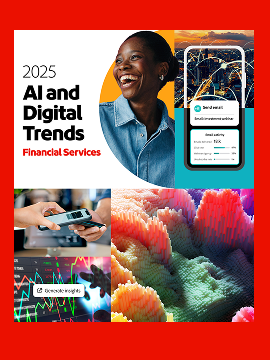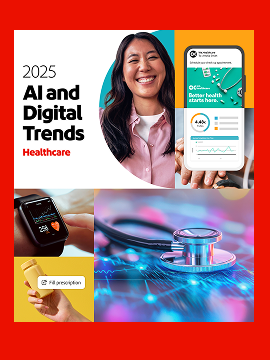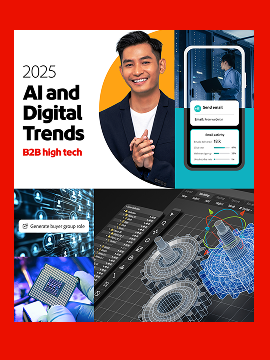Key learnings
Agentic AI opens new opportunities to enhance both experiences and workflows.
Autonomous AI agents working together will deliver efficiency gains and smarter support for marketers while providing consumers with a concierge-like experience of convenience, speed, and personalization. As this emerging solution gains a foothold, agentic AI is poised to reshape how marketers scale their efforts, improve quality, and boost conversions.
Organizations are moving beyond understanding customer needs to anticipating them.
What once felt exceptional is now the standard. Customers expect effortless, meaningful interactions — yet many organizations still struggle to deliver relevant and timely experiences across the entire journey. This year, AI and predictive analytics have emerged as top priorities, enabling teams to address these challenges.
Real-time insights depend on unified platforms built for connection and interoperability.
However, significant hurdles remain — particularly around how resources are allocated as organizations grapple with fragmented data and integration issues. Incremental approaches to connecting data often result in disjointed systems, unclear strategies, and failure to treat data as a strategic asset.
Disparity in ownership of the customer journey gets in the way of delivering consistent experiences.
Responsibility for the customer journey is often split between customer experience (CX) specialists, technologists, and marketers. While this structure brings diverse expertise, it also creates friction, resulting in disjointed experiences and wasted resources.
Companies are taking bold steps to unlock the potential of generative AI.
The benefits are transformative — accelerating revenue growth, boosting productivity, and enabling more efficient content creation. Establishing clear ROI metrics is critical for scaling these initiatives, and starts with fostering data unity and strong cross-departmental collaboration.
Privacy concerns and the complexity of AI adoption remain significant hurdles.
Integrating customer data demands robust privacy, security, and governance frameworks. As organizations deepen their AI adoption, managing these complexities demands greater focus and resources. Early adopters set clear objectives and metrics.

2025 Adobe AI and Digital Trends
Download the report
Discover the specific trends for your industry or the solution you need.
2025 AI and Digital Trends
Executive summary
Businesses are poised for meaningful change in 2025. They’ve aligned priorities and technologies to deliver truly personalized customer experiences — powered by advanced tools and smarter use of data, which have unlocked insights that were once out of reach. Most notably, the adoption of artificial intelligence (AI) is moving beyond the pilot stage and delivering measurable returns as leading organizations redefine how they connect with customers, streamline operations, and drive innovation.

Section 1
Driving growth through AI.
In 2025, AI and predictive analytics are redefining how marketers drive growth, enabling deeply tailored strategies that anticipate customer needs and deliver measurable business results.
From insights to innovation: personalization’s turbo boost.
Nearly two-thirds (65%) of senior executives identify leveraging AI and predictive analytics as primary contributors to growth in 2025 (Figure 1). These technologies have the potential to create next-level personalization — faster, at scale, and more efficient than ever before. With 61% of the senior executives agreeing that boosting customer engagement with personalized experiences will be critical to achieving growth, investment in these initiatives will be a priority.


Tech leads the way, but people stay at the center in 2025 plans.
It’s no surprise that senior executives are prioritizing technology, data, and digital strategies in their 2025 spending plans.
Eighty percent plan to increase spending on new technology, including 31% who expect to spend “significantly more.” Similarly, 79% intend to boost investment in customer data and analytics, and 78% plan to increase their digital media budgets.
However, technology investment isn’t replacing people. Reducing headcount remains a low priority; in fact, 69% of senior executives plan to increase spending on talent. Forward-thinking organizations view technology as a way to enhance human capabilities, not replace them.
Leading organizations recognize that success takes more than just adopting new tools.
“Generative AI isn’t a one-click solution; you still need skilled professionals, like copywriters, who understand brand nuances and audience expectations.”
Christen Jones, Executive Creative Director, Inizio Evoke
Transforming AI adoption into measurable results.
Using AI to support rather than replace talent pays off.
While companies like Mattel Future Lab are enjoying clear workflow benefits, converting these day-to-day gains into measurable business outcomes remains a common challenge. In fact, only 12% of organizations have working solutions in place that demonstrate a clear ROI (Figure 3).

“We’re using generative AI as a copilot for ideation, helping us iterate and validate ideas quickly. It allows us to put concepts on paper or screens faster, creating immediate feedback loops and improving collaboration.”
Ron Friedman, Vice President, Mattel Future Lab
For the majority, the challenge is in moving from pilot to proof. Encouragingly, over half are moving in the right direction, whether undertaking pilots and evaluating results (27%) or rolling out working solutions and evaluating their effectiveness (27%).
Transitioning from testing to full-scale adoption with measurable ROI requires undertaking meaningful steps in organizational change and financial investment, placing added pressure on marketing teams.
The rising demands on marketing.
The widening gap between the AI “haves” and “have nots” is especially visible in marketing, where teams face rising expectations. More than three-quarters (78%) of senior marketing executives say their organizations expect them to deliver growth using data and AI, even as new tools are being integrated into workflows.
Accountability is intensifying as marketers face mounting demands to deliver more of everything in 2025 compared to 2024. According to our survey, 44% of practitioners anticipate increased pressure to drive engagement and conversions. Similarly, 43% expect heightened demands to scale content output while keeping it personalized and relevant.
These efforts do pay off, however, as Amanda Forte, head of personal investor public site at Vanguard, explains: “With greater content creation speed, we can accelerate product launches and deliver updated, personalized content on the website. Because of this, we see much higher engagement on the new website, with a 264% increase in organic traffic and 176% increase in quality engagement.” Read the Vanguard story.
Marketers face increasing pressure to produce more content at a faster pace, but this can’t be at the expense of quality. As Helen Wallace, creative director at Deloitte Digital, points out: “Focusing on the content supply chain isn’t just about delivering content faster and more efficiently. It’s about creating and activating content that engages people on an individual level. We use technology to learn, improve, and respond to our clients.”

Section 2
Exceptional experiences start with connected Data.
Organizations are acutely aware of the need to bridge the gaps in their customer experience. But even with AI, delivering memorable experiences is getting tougher. Only 14% of practitioners report being able to deliver exceptional digital customer experiences that surprise and delight — a sharp decline from 25% last year.
Personalization is not just a name in a subject line; it’s about creating deep connections. Organizations stand out and build loyalty when they successfully deliver relevance and recognition at the right moment.
Leo Griffin, vice president and global head of consumer technology at HanesBrands Inc., says: “Personalization helps our consumers feel known. It helps them cut through the clutter and have an efficient and hopefully pleasurable shopping experience where they find what they want.” Read the HanesBrands Inc story.
However, personalization at scale is still more of an aspiration than a reality for most organizations. As Figure 4 shows, 71% of consumers want brands to anticipate their needs with personalized offers or helpful information, but only 34% of brands deliver. Similarly, 78% of consumers expect a seamless experience across digital and physical channels, yet only 45% of brands meet this expectation.
In fact, the majority of organizations under-deliver in every area — whether it’s offering interactive tools like virtual try-ons and product demos or being transparent about their use of AI and data.
Concerningly, 88% of consumers expect assurance that their personal data is handled responsibly and securely, but only 49% of organizations meet this expectation. This trust gap is particularly significant given that personalization depends on customers being willing to share their data in the first place.

These gaps help to explain why just 15% of organizations achieve surprise and delight in their customer engagements. Closing this divide requires organizations to align their digital investments with what matters most to their audiences — turning personalization at scale into a tangible reality.
For organizations willing to invest in personalization, the payoff is clear. Danish telecom provider Telmore’s AI-driven personalization delivered an 11% sales lift compared to non-personalized experiences.
As Frederik Scholten, Telmore’s CMO, explains: “We’re shifting away from optimizing experiences for audiences to giving each person what they want. Customers see more relevant offers, encouraging them to add on services or even switch over from competitors.” Read the Telmore story.
Why personalization still falls short.
The personalization execution gap largely stems from a lack of real-time capabilities. While 47% of practitioners use analytics to predict customer needs by segment or persona, only 39% routinely personalize website experiences, and just 31% update offers based on customers’ most recent activity (Figure 5).

TSB Bank demonstrates the transformative potential of bridging this gap. Using real-time data to personalize loan offers based on recent customer activity, mobile loan sales increased by 300%, while in-app applications jumped from 24% to 75% of total sales.
TSB’s CMO Emma Springham highlights why this matters: “Banking is inherently personal and has a more profound impact on customers than many other sectors. Personalized digital experiences help us to build deeper, more meaningful connections with those who trust us to manage their money.” Read the TSB story.
Fragmented data holds back real-time personalization.
Seamless data is the backbone of real-time personalization, whether customers are browsing or buying. On a scale ranging from sometimes impacted to critically challenged: Three quarters of practitioners report being unable to personalize in real time. This spans every aspect of personalization, from understanding customer behavior to delivering consistent messaging and engaging at critical moments (Figure 6).

As we’ll see in Section 4, executives often point to caution around data privacy, security, and governance as the biggest barriers to connecting customer data. However, while it’s true that data safety and transparency remain non-negotiable for consumers, the experiences they value depend on real-time access to data.
To compete, organizations must invest in connecting and unifying data, at the same time ensuring it’s accessed safely while meeting business needs.
From data silos to connected experiences.
Fragmented data isn’t the only challenge to seamless customer experiences. Most organizations have only partially automated — or not automated at all — key capabilities like personalized recommendations (74% not fully automated) and customer support (76%). These gaps are even wider in post-purchase engagement, such as retention (80%) and reactivating dormant customers (83%) (Figure 7).

Organizations are beginning to address these challenges. When asked about trends driving their technology investments, 62% of senior executives identify AI and machine learning advancements — particularly for workflows, decision-making, and hyper-personalization — as top priorities over the next 12 to 24 months. Other critical focus areas include data integration and real-time insights (55%) and enhancing security, privacy, and compliance governance (55%).
Employing unified tools, breaking down data silos, and improving team collaboration will be essential to turn these priorities into actionable progress.
Encouragingly, despite ongoing economic pressures, organizations are stepping up their investments to support these goals. Senior executives expect marketing budgets to rise across 2025, with 30% anticipating a significant increase of more than 10%.
In our final section, we’ll dive into how organizations will need to evolve to support AI-driven growth. But first, Section 3 focuses on how they can harness generative AI to boost productivity, unlock compounding advantages, and fuel continuous improvement and value creation.

Section 3
Generative AI expands from efficiency to engagement.
The generative AI revolution is in full swing, with ambitions and excitement running high — though caution and siloed approaches are slowing adoption and execution.

To stay competitive — let alone lead — organizations will need to commit faster and go further (Figure 8).
Difficulties in finding use cases and in securing necessary budgets (both at 47%) are the two challenges most frequently cited by senior executives who are still at the start of their generative AI journey (Figure 9).
As organizations advance in their AI adoption journey, challenges become more complex and nuanced. Those with working AI solutions focus on balancing innovation with ethical considerations, protecting brand reputation, and managing internal cultural shifts. The question is no longer one of whether and where to adopt AI, but how to implement it effectively and responsibly.

Success with AI demands urgency and precision.
Early adopters of rigorous ROI frameworks are surging ahead, leaving those without scrambling to catch up. Among companies with proven AI solutions, nearly two-thirds (64%) have completed their ROI measurement frameworks. In contrast, only 34% of those still in the pilot phase have developed robust metrics for tracking ROI (see Figure 10).
Those that delay, or fail to create these necessary foundations, will fall further and further behind. Organizations need to tackle regulatory frameworks, ROI tracking and metrics, and change management processes in parallel to scale AI effectively. As the figure below illustrates, forward-thinking organizations have embraced this synchronized approach.

However, scaling AI adoption also means addressing human challenges. Our survey reveals that 52% of organizations with proven ROI are now struggling to balance operational momentum with the cultural shifts needed to foster widespread employee support.
Even so, there are plenty of reasons for optimism — AI is already delivering results in the early stages of testing and adoption (Figure 11). Nearly half of organizations in pilot phases (48%) and more than half of those rolling out AI (53%) are reporting boosts in team productivity.

Organizations successfully leveraging AI are showcasing its transformative potential. Among those reporting proven ROI, 64% cite faster content production and higher productivity, while similar numbers point to improved decision-making, freed-up resources for strategy, and revenue growth.
As Eric Perez, vice president of Design hub at iHeartMedia, explains: “In fast-paced industries like radio, where everything is expected quickly, AI is a game changer. It speeds up brainstorming, concept development, and iterations, helping us meet rising demands without compromising quality or efficiency.”
Speed matters, but precision is just as important — achieving both requires clear priorities, targeted investments, and a deliberate focus on scaling adoption. Success isn’t just about technological advancements. It’s also about aligning teams, equipping leaders to navigate change, and fostering adaptability across the organization.
Accelerating AI adoption with virtual assistants leading the way.
Practitioners using generative AI with proven ROI anticipate two key benefits in the next 12-24 months: better quality interactions (58%) and greater communication consistency (50%). These capabilities will help deliver against consumers’ key expectations for brand engagement (see Section 2, Figure 4).
Practitioners are advancing generative AI efforts, focusing on chat and customer support tools — which are already delivering ROI for one in five users (19%) (Figure 12). Meanwhile, personalized customer journeys and content generation (video and static images) are emerging as high-growth opportunities. Although only 13% of practitioners report ROI in these areas, a notable 22% and 29% have yet to begin adoption.

The evolution toward agentic AI.
As these advancements continue, consumers are demanding more adaptive, autonomous AI-powered support. Our consumer survey shows that nearly half of respondents would turn to an AI-powered assistant over a static web experience for tasks such as scheduling appointments or troubleshooting issues (Figure 13).

During 2024’s Cyber Monday, that’s exactly what they did, with a 1,950% year-over-year increase in retail site traffic from chatbot interactions. This surge in adoption highlights the readiness of consumers to embrace more advanced tools, including “agentic AI” or “AI agents.”
Agentic AI reimagines what virtual assistants can do. Moving beyond simple tasks like tracking orders or updating account details, it takes the initiative — offering virtual product trials, personalized recommendations, and proactively providing support.
Being autonomous, agentic AI combines operational efficiency with standout, white-glove customer experiences. This is where organizations finally make the full leap from simply understanding consumer needs to anticipating them.
Younger audiences, in particular, show enthusiasm for these advanced features. As Figure 14 illustrates, nearly half of consumers under 45 welcome the idea of virtual shopping assistants that proactively add items to their carts based on their style preferences and past purchases.


Section 4
Balancing innovation, trust, and organizational change.
Generative AI is fueling growth, but scaling it from pilot to full adoption takes more than just technology — it requires the right talent, processes, and organizational mindset. Encouragingly, AI tools can help meet these demands, refining workflows and boosting both the volume and quality of output.
Rising demand, limited resources: The case for operational agentic AI.
Senior executives see immense potential in generative AI, with 86% expecting it to significantly increase content speed and volume. For marketing and CX teams, however, the reality is more complex — 56% report that implementing generative AI adds strain to their workflows.
While the technology excels at content creation, it still requires oversight, leaving teams to juggle higher volumes and address operational gaps across the customer journey.
This is where agentic AI steps in. By automating repetitive tasks and optimizing decision-making, it frees up marketers and CX teams to focus on strategic outcomes.
Integrated into assistants and copilots, agentic AI handles time-consuming tasks like data collection, database management, and content delivery. For example, it enhances channel marketing campaigns by streamlining audience segmentation, personalizing outreach, and scheduling tasks — all while keeping workflows efficient.
Together, generative and agentic AI empower organizations to deliver personalization at scale with greater speed and impact.
However, these systems can only go so far without the right foundation: unified, robust data systems that ensure AI can operate effectively and deliver meaningful results. Without strong data infrastructure, even the most advanced systems fall short.
Building a strong data foundation.
Data powers every aspect of AI growth, but technical challenges often get in the way. Disconnected systems, siloed teams, and poor integration create gaps that limit real-time personalization and erode consumer trust. This creates a challenging cycle — consumers won’t share data without trust, yet data is essential for AI advancement. The stakes are high: 88% of consumers say responsible and secure data handling is important, with 60% rating it as critical.
Max Cuellar, vice president of marketing strategy, performance, and innovation for Adobe Digital Experience, explains: “If you’re piloting AI in a specific organizational cell, you’re often working with a narrow data domain and trying to figure out how to connect it to a broader data strategy. Taking time upfront to structure data at scale unlocks efficiencies, creates synergies, and leads to better outcomes in data management.”
As highlighted in Section 2, executives are making bold moves, with many planning to increase technology and data transformation budgets by over 10% in 2025 compared to 2024. However, key challenges remain — particularly around how resources are allocated as organizations grapple with fragmented data and integration issues.
Figure 15 pinpoints critical gaps. For instance, 33% of organizations report budget shortfalls for essential technology and tools, limiting their ability to connect data. To fully realize AI’s potential, organizations must prioritize funding for AI technologies — often requiring substantial investments — and initiatives that integrate customer data.
Additional barriers further complicate these efforts. Fragmented IT systems (32%) and unclear data strategies (30%) hinder progress, while 24% of organizations do not yet recognize data as a strategic asset.

We also asked senior executives to indicate which best reflects their organization’s approach to personalization and data: by gradually connecting databases across departments or by fully unifying business-critical data into a single source of truth. Most senior executives (57%) said the incremental approach better describes their organization, while 43% said their organization has taken a fully unified approach.
Incremental steps can deliver quick wins, but a unified platform built for connection, interoperability, and scalability unlocks a compounding cycle of benefits. It enables AI-driven tools to move seamlessly across applications, fueling hyper-personalized experiences and creating a foundation for innovations that multiply efficiency and impact over time.
Encouragingly, as we saw earlier in Section 2, more than half of senior executives (55%) say building unified data ecosystems will shape their technology decisions in the next 12–24 months.
Defining distributed ownership of the customer journey.
Organizations may be making strides towards unifying data, but the lack of consensus over who owns the customer journey is a sticking point. Our survey reveals that most organizations distribute responsibility for this journey across three key areas: CX teams, technologists, and marketing.
Yet, this division often leads to friction between teams and disrupts organizations’ ability to achieve their goals — namely, personalization at scale.
As shown in Figure 16, marketers predominantly see customer journey ownership as shared between CX teams (42%) and marketing (32%), with technology teams playing only a minimal role (6%). However, their perspective differs sharply from that of technology teams — 55% believe they hold primary responsibility, acknowledging CX teams (25%) but giving little credit to marketing (3%).

However, there’s a bright spot: CX teams are emerging as a common ground between these disciplines, with 42% of marketers and 25% of technology executives recognizing them as holding primary responsibility for the customer journey.
Fostering collaboration will be essential as agentic AI gains traction and tackles complex tasks that span organizational boundaries. Strengthening alignment across teams and systems is key to making personalization at scale both practical and achievable.
AI’s role in CX and marketing: Aligning marketing and technology teams.
The contrasting priorities are clear: Tech teams focus on scalability and infrastructure (43% prioritizing predictive AI, 38% streamlining processes), while marketing teams channel AI into creativity (42% emphasizing content creation, 37% driving ideation) (Figure 17).

On a positive note, these aren’t competing priorities but complementary strengths that can transform customer engagement. The real opportunity lies in bridging silos. Tech teams lay the groundwork for marketing’s creative innovation, while CX teams ensure all efforts align with customer needs and expectations.
Generative AI adoption reveals organizational challenges like fragmented ownership but also inspires solutions. By turning these tensions into opportunities, companies can build strong foundations for the future of customer engagement. Those that prioritize unified data strategies, clear goals, and integrated systems will lead the way in delivering personalized experiences and driving meaningful innovation. For those determined to stay ahead, the time to act is now.
Create AI capabilities that deliver sustainable value.
Start by assembling teams that combine AI expertise with access to quality data and robust infrastructure. Focus on projects with clear, measurable outcomes — like streamlining content creation — to build confidence and demonstrate impact quickly. These early successes do more than validate the investment; they create a ripple effect, paving the way for more ambitious goals, like proactive, tailored white-glove experiences that set your organization apart.
Invest in technologies that enable dynamic, behavior-driven personalization.
Delivering personalization that is both context-aware and adaptive across channels helps deepen customer connections, boost engagement, and stay ahead of their constantly shifting needs. Working with agentic systems takes this a step further, anticipating what customers want and autonomously managing tasks. By offering this level of seamless, intuitive interaction, you create experiences that feel effortless while fostering trust and loyalty.
Unify data for seamless teamwork and exceptional customer experiences.
Fragmented systems are a barrier to collaboration, hindering innovation and efficiency. A unified platform designed for connection and interoperability unlocks deeper insights, streamlines processes, and fosters creativity. With high-quality, accessible data, organizations can empower teams to work more effectively, safeguard customer privacy, and deliver deeply personalized experiences that resonate.
Appoint a champion to unite strategies and align efforts.
Executive sponsors play a key role in addressing disconnects between marketing, technology, and customer experience teams. By fostering alignment and encouraging collaboration around shared goals, they empower teams to experiment and innovate. With the right guidance, AI can move beyond isolated pilots to deliver scalable solutions with measurable ROI. A culture rooted in curiosity, creativity, and continuous learning ensures ongoing progress, unlocking your organization’s full potential.
Executive survey
The survey collected 3,400 qualified respondents from November 11 to December 4, 2024, including 3,270 client-side and 130 agency executives.
- Seniority and market: 39% were senior director, VP/SVP/EVP, or above (“Senior Executives”), with 61% being “Practitioners” (directors, managers, and junior executives). In terms of market focus 33% served B2B, 23% B2C, and 43% equally.
- Geography and industry: APAC led with 37% of respondents, followed by Europe (32%) and North America (31%). Key sectors included Retail (24%), B2B Tech (23%), Financial Services (20%), Healthcare (17%), and Media and Entertainment (10%).
- Function: Respondents span various departments, with strong representation from IT (25%), Marketing (13%), Advertising (12%), and Digital/Technology (8%).
Generative AI adoption
We asked senior executives and practitioners to characterize their current generative AI implementation status for marketing and customer experience initiatives. Based on the answers selected, we grouped the responses into:
- No formal adoption: Actively discouraging the use of generative AI/Informal adoption at an individual or team level
- Piloting: Most projects are at pilot stage and being evaluated
- Roll out and evaluation: Rolled out working solutions and are evaluating their effectiveness
- In use with proven ROI: Working solutions in place and have been able to demonstrate ROI
Functional groupings
We used three main groupings:
- Marketing: Marketing, content/editorial, product management, advertising, design or creative services.
- Technology: IT, digital/technology, web or app development, privacy/security.
- Other: Business operations, customer service, ecommerce, analytics, consulting, HR, product management, research and development.
Consumer survey
The survey gathered insights from 8,301 respondents during November and December 2024:
- Gender: 51% female, 49% male.
- Age distribution: 31% (18–34), 36% (35–54), 33% (55+).
- Regional spread: Europe (35%), APAC (31%), North America (23%), South America (12%).
- Industries: Respondents were screened to ensure recent engagement with digital communications across sectors, including retail, financial services, healthcare, media/entertainment, travel, and telecommunications.
